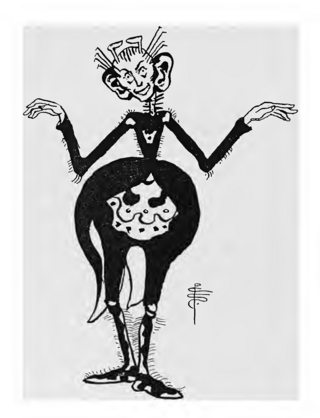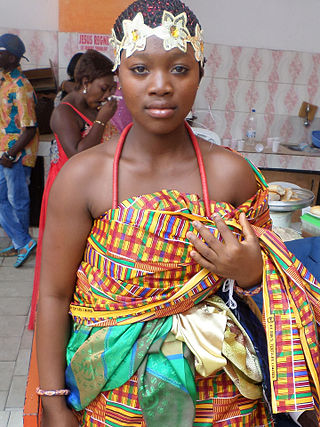
Vodun is a religion practiced by the Aja, Ewe, and Fon peoples of Benin, Togo, Ghana, and Nigeria.

Anansi or Ananse is an Akan folktale character associated with stories, wisdom, knowledge, and trickery, most commonly depicted as a spider, in Akan folklore. Taking the role of a trickster, he is also one of the most important characters of West African, African American and West Indian folklore. Originating in Ghana, these spider tales were transmitted to the Caribbean by way of the transatlantic slave trade.

Onyame, Nyankopon (Onyankapon) or Odomankoma is the supreme god of the Akan people of Ghana, who is most commonly known as Anyame. The name means "The one who knows and sees everything", and "omniscient, omnipotent sky deity" in the Akan language.

The Bono, also called the Brong and the Abron, are an Akan people of West Africa. Bonos are normally tagged Akan piesie or Akandifo of which Akan is a derivative name. Bono is the genesis and cradle of Akans. Bono is one of the largest ethnic group of Akan and are matrilineal people. Bono people speak the Bono Twi of Akan language. Twi language, thus the dialect of Bono is a derivative of a Bono King Nana Twi. In the late fifteenth century, the Bono people founded the Gyaaman kingdom as extension of Bono state in what is now Ghana and Côte d'Ivoire.

The beliefs and practices of African people are highly diverse, including various ethnic religions. Generally, these traditions are oral rather than scriptural and are passed down from one generation to another through folk tales, songs, and festivals, and include beliefs in spirits and higher and lower gods, sometimes including a supreme being, as well as the veneration of the dead, and use of magic and traditional African medicine. Most religions can be described as animistic with various polytheistic and pantheistic aspects. The role of humanity is generally seen as one of harmonizing nature with the supernatural.

Tambor de Mina is an Afro-Brazilian religious tradition, practiced mainly in the Brazilian states of Maranhão, Piauí, Pará and the Amazon rainforest.

Winti is an Afro-Surinamese traditional religion that originated in Suriname. It is a syncretization of the different African religious beliefs and practices brought in mainly by enslaved Akan, Fon and Kongo people during the Dutch slave trade. The religion has no written sources, nor a central authority. The term is also used for all supernatural beings or spirits (Wintis) created by Anana, the creator of the universe.

Asase Ya/Afua is the Akan goddess of fertility, love, procreation, peace, truth and the dry and lush earth in Ghana and Ivory Coast. She is also Mother of the Dead known as Mother Earth or Aberewaa.
Afro-Jamaicans are Jamaicans of predominant African descent. They represent the largest ethnic group in the country.
In the spiritual practices of the Ashanti people and Akan people, the sunsum is one's spirit. The sunsum is what connects the body (honam) to the soul (kra). The sunsum can be transmitted in a variety of ways, including from father to son during conception. This power is used to protect the carriers of this spirit. When a man dies, the sunsum returns to the metaphorical house of the father in wait to be reincarnated in the next son born of the men of that family.

The Akwasidae Festival is celebrated by the Ashanti people and chiefs in Ashanti, as well as the Ashanti diaspora. The festival is celebrated on a Sunday, once every six weeks.

Myal is an Afro-Jamaican spirituality. It developed via the creolization of African religions during the slave era in Jamaica. It incorporates ritualistic magic, spiritual possession and dancing. Unlike Obeah, its practices focus more on the connection of spirits with humans. Over time, Myal began to meld with Christian practices and created the religious tradition known as Revivalism.
The traditional Jamaican Maroon religion, otherwise known as Kumfu, was developed by a mixing of West and Central African religious practices in Maroon communities. While the traditional religion of the Maroons was absorbed by Christianity due to conversions in Maroon communities, many old practices continued on. Some have speculated that Jamaican Maroon religion helped the development of Kumina and Convince. The religious Kromanti dance is still practiced today but not always with the full religious connotation as in the past.
Comfa is a folk religion in Guyana also known as Spiritualism or Faithism. The word "Comfa" is used by non-practitioners as a generic term for spirit possession in Guyana. However, the word "Comfa" is also a term to define the greater folk religion involving spirit possession originating in Guyana.

The Ashanti Empire was governed by an elected monarch with its political power centralised. The entire government was a federation. By the 19th century, the Empire had a total population of 3 million. The Ashanti society was matrilineal as most families were extended and were headed by a male elder who was assisted by a female elder. Asante twi was the most common and official language. At its peak from the 18th–19th centuries, the Empire extended from the Komoé River in the West to the Togo Mountains in the East.
Tano (Tanoɛ), whose true name is Ta Kora, but is often confused with Tano Akora, and is known as Tando to the Fante is the Abosom of war and strife in Akan mythology and Abosom of Thunder and Lightning in the Asante mythology of Ghana as well as the Agni mythology of the Ivory Coast. He represents the Tano River, which is located in Ghana. He is regarded as the highest atano, or Tano abosom in Akan mythology.
Owuo is the abosom of Death in the Asante and Akan mythology of West Ghana and the Ewe, specifically the Krachi tribe of East Ghana and Togo. He is represented with the Adinkra symbol of a ladder. It is said that he was created by Odomankoma just so he could kill humans and possibly other deities, such as Odomankoma himself. He signifies the termination of the creative process in the world, a reference to him killing Odomankoma, the Great Creator












